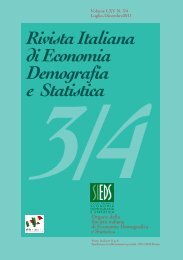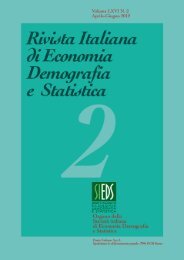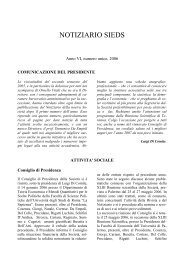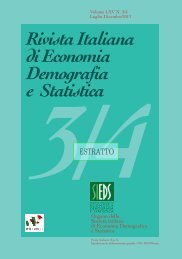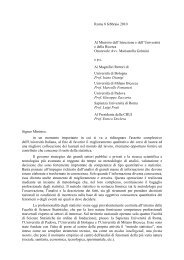rivista italiana di economia demografia e statistica - Sieds
rivista italiana di economia demografia e statistica - Sieds
rivista italiana di economia demografia e statistica - Sieds
You also want an ePaper? Increase the reach of your titles
YUMPU automatically turns print PDFs into web optimized ePapers that Google loves.
30<br />
Volume LXIII nn. 3-4 – Luglio-Dicembre 2009<br />
Riferimenti bibliografici essenziali<br />
Baio G., Blangiardo G.C., Blangiardo M. 2008. Centre sampling technique in foreign<br />
migration surveys: a methodological note. Quaderno <strong>di</strong> <strong>di</strong>partimento, 6, pp 1-13. Milano.<br />
Banca d’Italia 2008. I bilanci delle famiglie italiane nell’anno 2006. Supplemento al<br />
Bollettino statistico. Indagini Campionarie. Nuova serie. Anno XVIII, Numero 7. Roma.<br />
Barsotti O., Moretti E. (a cura), 2004, Rimesse e cooperazione allo sviluppo, Franco<br />
Angeli, Milano.<br />
Blangiardo G.C. (a cura) 2008. L’immigrazione straniera in Lombar<strong>di</strong>a. La settima<br />
indagine regionale. Rapporto 2007. Fondazione ISMU. Milano.<br />
Chelli F., Paterno A. 2002. Misurazione del livello <strong>di</strong> povertà in un collettivo <strong>di</strong> immigrati: due<br />
meto<strong>di</strong> a confronto, in Rivista Italiana <strong>di</strong> Economia, Demografia e Statistica, 4, 11-30.<br />
Chelli F., Paterno A. 2006. La povertà. In: Sospesi tra due rive: migrazioni e inse<strong>di</strong>amenti<br />
<strong>di</strong> marocchini e albanesi, Paterno A., Strozza S., Terzera L., (a cura), pp 192-206, Franco<br />
Angeli, Milano.<br />
Commissione d’indagine sull’esclusione sociale 2000. Rapporto annuale sulle politiche<br />
contro la povertà e l’esclusione sociale, Presidenza del Consiglio dei Ministri,<br />
Dipartimento per gli Affari Sociali, Roma.<br />
ISTAT 2008. La povertà relativa in Italia nel 2007. Statistiche in breve. Famiglia e Società.<br />
Merlini A. 1992. Un metodo per la formazione dei gruppi quando è richiesto che essi siano<br />
in una relazione or<strong>di</strong>nale, Quaderni dell’Istituto <strong>di</strong> Matematica e Statistica, Università <strong>di</strong><br />
Ancona.<br />
SUMMARY<br />
The rapid growth of the number of migrants living in Italy during the last<br />
decades has aroused great interest in the analysis of migrants’ characteristics,<br />
especially standard of living. However, the existing approaches for the<br />
determination of poverty line are not sufficiently suitable for the foreign<br />
population. Indeed migrants present a specific consumption profile and are more<br />
inclined to saving in order to send money at their original country. In order to<br />
estimate the percentage of poor families living in Lombardy, to introduce the<br />
multi<strong>di</strong>mensional aspect of poverty con<strong>di</strong>tion and to describe the <strong>di</strong>fferent<br />
characteristics of migrant families, we combine the International Standard of<br />
Poverty Line method with an iterative <strong>di</strong>scriminant analysis.<br />
Elisa BARBIANO DI BELGIOJOSO, Assegnista <strong>di</strong> ricerca in Demografia,<br />
Dipartimento <strong>di</strong> Statistica, Università <strong>di</strong> Milano-Bicocca.<br />
Francesco M. CHELLI, Professore straor<strong>di</strong>nario <strong>di</strong> Statistica Economica,<br />
Dipartimento <strong>di</strong> Economia, Università Politecnica delle Marche.<br />
Anna PATERNO, Professore associato <strong>di</strong> Demografia, Dipartimento per lo Stu<strong>di</strong>o<br />
delle Società Me<strong>di</strong>terranee, Università <strong>di</strong> Bari.



